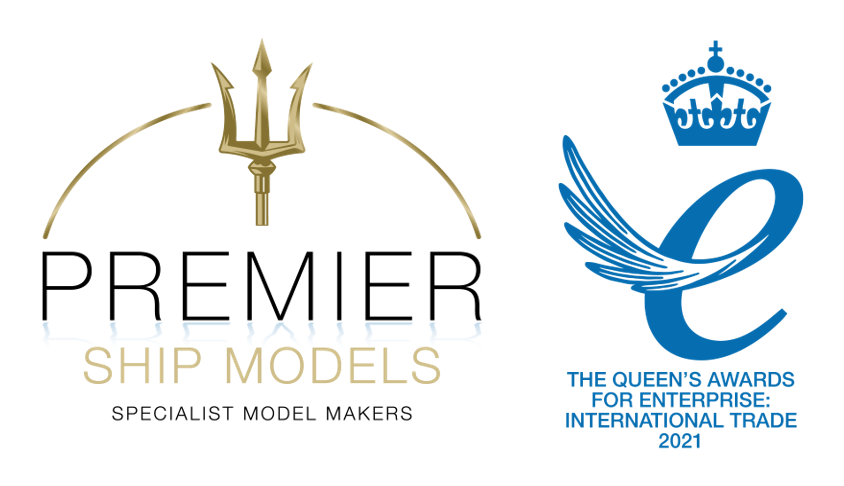Premier Ship Models have been tasked with an order of 50 models of the Le Commandant Charcot, an icebreaking cruise ship manufactured and operated by the French shipping company Compagnie du Ponant.
The ship itself is named after a French polar scientist, Jean-Baptiste Charcot, although the vessel was actually constructed in Romania, before moving to Søviknes, Norway, in 2021, ready for delivery.
Le Commandant Charcot is in fact the world’s only ‘Luxury Icebreaker,’ and is powered by liquefied natural gas. It can accommodate up to 245 guests together with 215 crew members, and has 123 staterooms and suites. Furthermore, the vessel has a spa on board, as well as two high-end restaurants.
This case study will largely refer to the singular prototype model we constructed initially, to ensure the client was pleased with the final result, before we make a larger quantity of them.
The model is complete with an elegant wooden base with brass fittings, a red, blue, black and white colour scheme, and highly intricate details spanning the entire deck. This includes hot tubs, decking, chairs, tables, lifeboats and swimming pools. Furthermore, the model is complete with accurate logos, using the same fonts as the real-life counterpart, as well as a helipad towards the bow.
Overall, this is a wonderful replica of Le Commandant Charcot, and makes for a terrific collector’s item for maritime – and specifically cruise ship – enthusiasts.
The client is Compagnie du Ponant themselves. They were founded in April 1988 by Phillipe Videua and Jean-Emmanuel Sauvé, together with officers of the French Merchant Navy.
As of March 2024, the company oversees the operations of eleven ships, and they each sail under the French flag.
Le Commandant Charcot is the latest addition to their fleet, with other notable ships comprising of Le Champlain, Le Boréal and Le Ponant.
The model was to be 3D printed, and it measured 75 centimetres in length, 16 in width and 32 in height (excluding the base).
In terms of materials used, the model was solely constructed from ABS resin, with timber for the base and brass stands.
3D-printing is an incredibly complex profession. It requires you to understand three main things:
- The material
- The printer
- The methodology of the piece and your desired end result
The entire process is extremely specialist. An off-site 3D-printing agent focuses on two skillsets when constructing models: creating the model in a digital manner and readying it for printing, and the separate skillset to take the parts from the printer and get them to a professionally high-standard.
We initially held a number of meetings with Ponant to ensure we had their exact requirements and desires in mind before work on the prototype began. They kindly supplied us with plans and layouts of the actual ship, so our model recreation could be as accurate and realistic as humanly possible.
As part of the preparation for 3D printing, we start by creating an initial digital model. This is done using specialised software, and is perhaps the simplest part of the process.
To optimize efficiency, production is then temporarily halted to allow the client to approve this digital render. Once approval is obtained, production will resume. Urgency is paramount in this phase to save time and resources and enhance overall efficiency.
A critical phase involves converting the digital render into a format compatible with the 3D printer, requiring the use of more specific software. Before conversion, the render is segmented into parts, each appropriately named and saved. Then, another software tool ensures that these parts are print-ready, verifying their scale, structural integrity, and even water resistance.
Upon completion of the render, laser-cutting and CNC machines facilitate the printing process, paving the way for construction. The construction phase, or ‘finishing,’ as it’s often referred to, involves hands-on work by specialists. Typically, the hull of a traditional model is divided into three sections, each with joints that are carefully glued and left to set before further features are added. Prior to adding more components, the hull undergoes painting to safeguard the adhesive’s strength, ensuring the model’s structural strength.
After that, our 3D-modeller focuses on arranging and preparing smaller components, meticulously cleaning and painting each one individually.
Throughout our projects, we maintain frequent communication with the client, providing them with updates through photos and renders. In this instance, their feedback was actively incorporated into the model to ensure their satisfaction with the progress.
Our first attempt at the prototype saw us encountering a few issues. For starters, we added a bit too much detail to certain areas, for instance, we included a helicopter on the helipad, when this was not requested. Additionally, we couldn’t get the font on the side of the ship exactly right, and a few of the colours were a few shades off.
However, these setbacks are natural for a prototype model, and we’re happy to received feedback early on, so the bulk orders can be perfect.
In the months that followed, we worked hard to incorporate their feedback, and make the model exactly as they wanted. They were left thrilled with the final result, and bulk production then started.
It was an honour to work with a company as prestigious as Ponant. They hold such an integral presence in the maritime – and specifically the luxury sector – industry, and we were proud of our standard of work.
We’re so happy with the end result, and more importantly are thrilled that the client was left highly satisfied as well!
Commission your own model
If you would like to have your own bespoke model built, please complete the contact form below.


